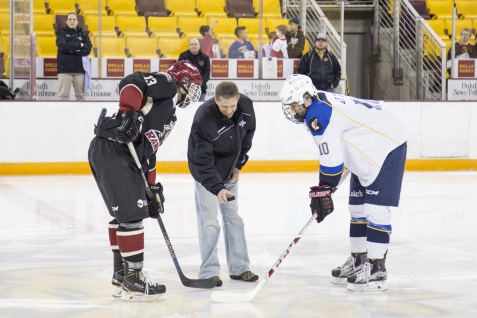The Athlete’s Advocate: A Team Approach to Sports Medicine at Aspirus St. Luke's
 Published in Moms & Dads Today magazine, September/October 2016
Published in Moms & Dads Today magazine, September/October 2016
The Athlete’s Advocate: A Team Approach to Sports Medicine at St. Luke’s
“Mom, dad, I want to play hockey!” Many parents hear sentences similar to this whether the sport in question is soccer, football, or one of the other numerous athletic activities available for children. Youth sports, while providing great life lessons, can result in injury. Dr. John Watkins, a fellowship-trained orthopedic surgeon with St. Luke’s Orthopedics & Sports Medicine, gives advice on how to keep young athletes safe and explains how St. Luke’s team of sports medicine physicians, physician assistants and athletic trainers can help if an injury occurs.
“The St. Luke’s sports medicine team truly acts as the athlete’s advocate,” explains Dr. Watkins. “It doesn’t matter if there is a big game tomorrow and the team needs the athlete competing—we put the safety of the athlete first, every time.”
Preventing sports-related injuries should always be the goal. “Overall conditioning is important—even in the off season,” Dr. Watkins explains. Through a balanced diet, stretching, core strengthening and balance exercises, young athletes not only perform better but also get injured less. “It’s important to warm up before playing a sport, cool down after, and stay hydrated throughout,” Dr. Watkins stresses.
St. Luke’s athletic trainers often spend time in the community leading off-season education on the benefits of overall conditioning and healthy training regimens. Warm ups and cool downs help prepare muscles for exercise and maintain flexibility after. Especially if your child participates in endurance sports, proper nutrition plays an important role in maintaining bone strength, hormone levels and more.
Types of sports-related injuries vary by age of the child and by the sport they are playing. In younger children, overuse injuries affecting soft tissue and growth plates are most common. “Younger children typically need less aggressive treatments and less time to heal,” says Dr. Watkins. “We joke that young kids are mostly cartilage because of their tendency to rebound more quickly than high school athletes and adults.”
Significant injuries such as shoulder separation, injuries to the anterior cruciate ligament (ACL) in the knee, concussions and fractures are more common in high school athletes than younger children. If you think that your child might have a sports-related injury, there are some symptoms you can look for. Any injury that causes numbness, tingling, altered feeling, persistent swelling after icing and ibuprofen, weakness or restricted motion should be evaluated by a professional. “Neck and back injuries need to be evaluated more rapidly,” adds Dr. Watkins. “They can appear minor even if they are serious.”
If you are worried that your child sustained a head injury, look for sensitivity to light, headaches, nausea, vomiting, memory loss or unusual pupil dilation. “In recent years, greater attention has been given to closed head injuries, like concussions, in sports,” says Dr. Watkins. Thanks to health campaigns and efforts made by professional sports leagues and lawmakers, a higher number of athletes with concussions are getting the medical attention they need. Dr. Watkins explains, “More people are learning signs of concussions and ways to avoid them, which is a great improvement for young athletes.”
To prevent possible aggravation of any injury and for parents’ peace of mind, Dr. Watkins encourages parents who aren’t sure how severe their child’s injury is to bring their child in. “St. Luke’s uses a team approach to sports medicine,” explains Dr. Watkins. Athletic trainers are the first line of defense on the field if your child is injured while playing a sport, and they work in-office at St. Luke’s as well. “Athletic trainers, physician assistants and doctors follow three steps: ‘evaluation, treatment, and rehab.’” Physicians and physician assistants often begin the evaluation steps. Physicians then complete the evaluation, determine treatment options and perform surgeries or other more aggressive treatments. Athletic trainers educate patients on the steps of rehabilitation and physical therapy exercises during their visit. If needed, patients are then referred to outpatient rehab.
As a father of two young athletes, Dr. Watkins is involved in the community as a parent, a physician and a spectator. “Children and teens can learn a lot through athletics,” says Dr. Watkins. “Even if they don’t realize it at the time, they are learning how to work with a team, what it means to have a strong work ethic, and even how to respond constructively to adversity. The benefits of playing sports far outweigh the risk of injury.”
